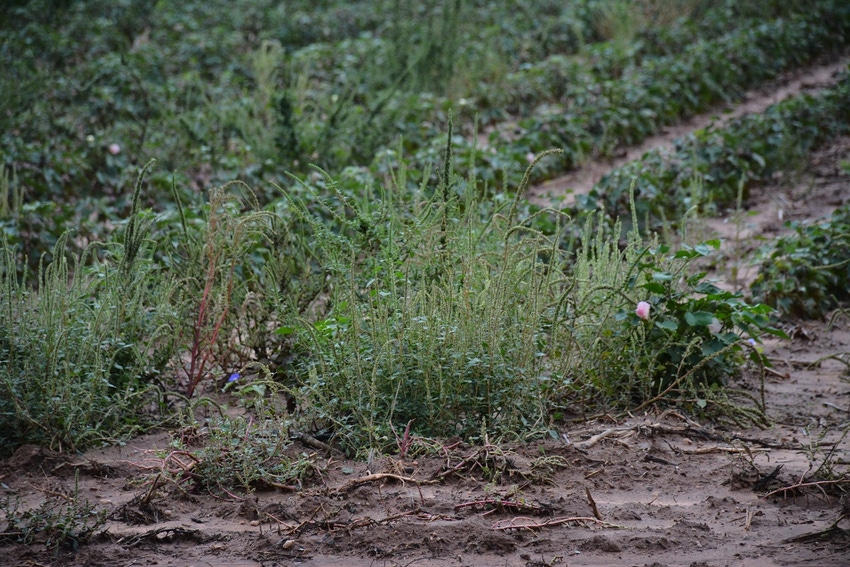
Editor's note:
The message is rather simple: start clean, stay clean; use different modes of action; provide overlapping layers of residual herbicides throughout the season; zero tolerance is the goal; you can’t afford to cut back on weed control.
Cotton farmers face an uphill battle this year as they develop weed control programs that take care of what many expect to be a banner year for glyphosate resistant weeds, especially pigweed. Compounding the problem is the depressed cotton market and the need to manage production costs as closely as possible—without sacrificing profit potential. A recent unprecedented gathering of representatives from nine major herbicide manufacturers in West Texas underlines the importance of the issue and the commitment of industry to cooperate to find solutions. Southwest Farm Press editor Ron Smith covered that meeting and developed this three-part series to show some of the options farmers have to manage tough weed issues. It will take a “back to the future approach,” says Helena Chemical Company’s Michael Kenty.
Back to the Future weed control strategies Part 1
Resistance is nothing new; it’s been around for decades.
Farmers, Extension specialist and industry representatives understand the dire need to get a handle on glyphosate resistant weeds, especially pigweed, in West Texas cotton.
It’s the execution of a thorough, efficient and effective resistant-weed management program that’s hard to fathom. “Zero tolerance is expensive,” says John Everitt, Monsanto. “It’s also time-consuming, but you can’t cut back too much and risk heavy weed infestations and yield losses.”
For the latest on southwest agriculture, please check out Southwest Farm Press Daily and receive the latest news right to your inbox.
Everitt was one of nine agricultural company representatives assembled by Helena Chemical Company at Anson, Texas, recently to provide cotton and grain producers management options to control herbicide-resistant weeds.
The issue takes on even more significance for 2015. Weed populations last summer were heavy, devastatingly so in some fields, and a lot of weeds went to seed, setting up potential for even heavier infestations this year. Also, as cotton prices struggle to stay in the 60-cent-a-pound range, farmers look for places to trim a few dollars off production costs.
Business as usual is not an option, says Michael Kenty, Helena. “What’s coming if we don’t change what we’re doing? The companies gathered here are united to overcome herbicide resistance. We don’t want Southwest farmers to have to deal with what farmers had in the Southeast.”
IPM is necessary
He says an integrated pest management approach will be necessary. That includes layering products from early-season burndown, to preplant applications, pre-emerge treatments, postemergence control and late-season removal��—by whatever means necessary—to eliminate escapes. The program may require cultivation or hand labor to remove persistent weeds.
“We may see a little phyto toxicity with some of these treatments,” Kenty says, “but it’s part of the program.”
Resistance is nothing new. “They discovered 2, 4-D back in the ‘40s, and resistance developed. We have identified 150 weeds in the United States resistant to herbicides. Some weeds are resistant to multiple modes of action, and some are even resistant to yellow herbicides.”
The United States is “the world leader in glyphosate-resistant weeds,” a dubious distinction achieved recently over second place Australia. Mississippi holds the honor as state with the most Roundup resistant weeds.
Texas has two for certain—Palmer amaranth (pigweed) and waterhemp—but others are under suspicion.
Genetically modified crops, company reps say, may have been the catalyst for uncovering resistance but did not cause it. “Herbicides do not cause resistance,” Kenty says. “We cause resistance. GMOs are great tools but when we use only one product we will see problems.”
Roundup is still a good product,” says Everitt, “but we have to use it with or after residual herbicides. We don’t have anything new this year; we have to go back to some older products that still work.”
Reliance on a single mode of action is culprit
Relying on one product sets the table for resistant weeds to become dominant. “We kill all the others, and if one resistant weed is left it produces many more from seed. In year two, we see many more resistant plants. In year three, half of the weeds in a field will be resistant. By the fourth year, most weeds are resistant and control becomes extremely difficult.
“Using the same mode of action shifts the weed population to resistant plants, and they become dominant and dictate what you do, agronomically and financially,” Kenty says.
Weed control expense has risen sharply over the last decade. “In 2002, weed control expense was about $20 per acre,” says Jacob Reed, BASF. “In 2010, weed control cost was $63 per acre.” Adding resistant weeds to the mix likely will push costs even higher. If hand labor is necessary, producers may expect expenses as high as $100 per day to chop weeds, haul them out of the field and burn them.
“A field can get out of control quickly,” says Don Johnson, FMC. “That’s a lesson learned in Arkansas. Shoot for zero tolerance. That’s the only option for pigweed.”
Even that may not be enough if neighbors don’t eliminate resistant weeds from their farms, including ditch banks and turnrows. Also, government agencies have to cooperate to control weeds along railroad rights of way and highway medians. Backyards also offer refuge for resistant weed species.
About the Author(s)
You May Also Like






